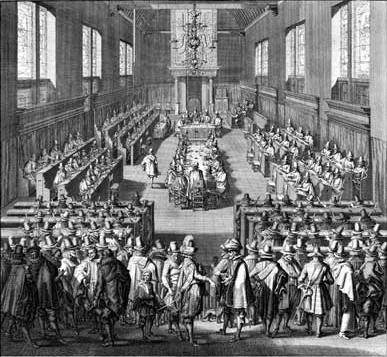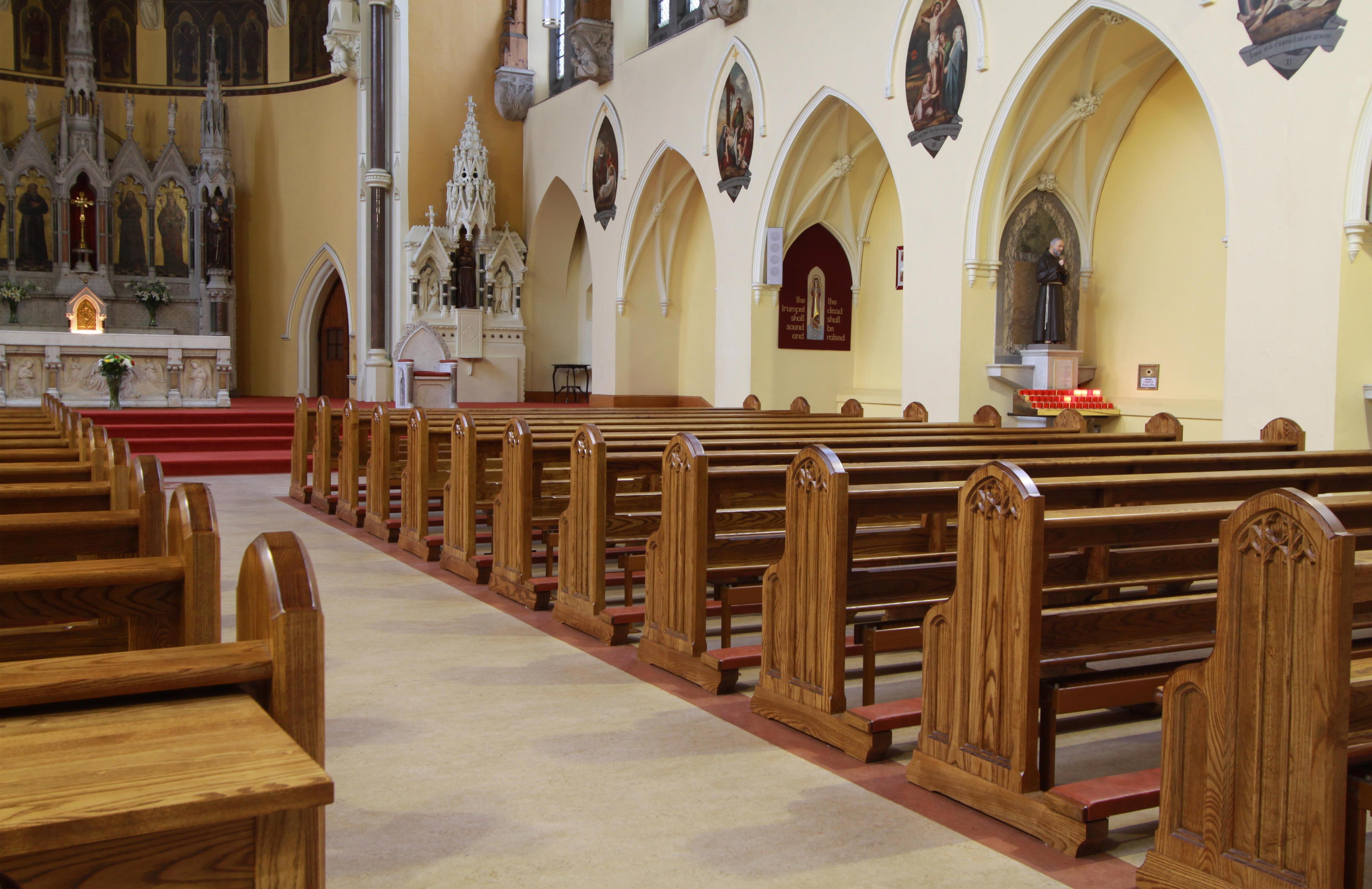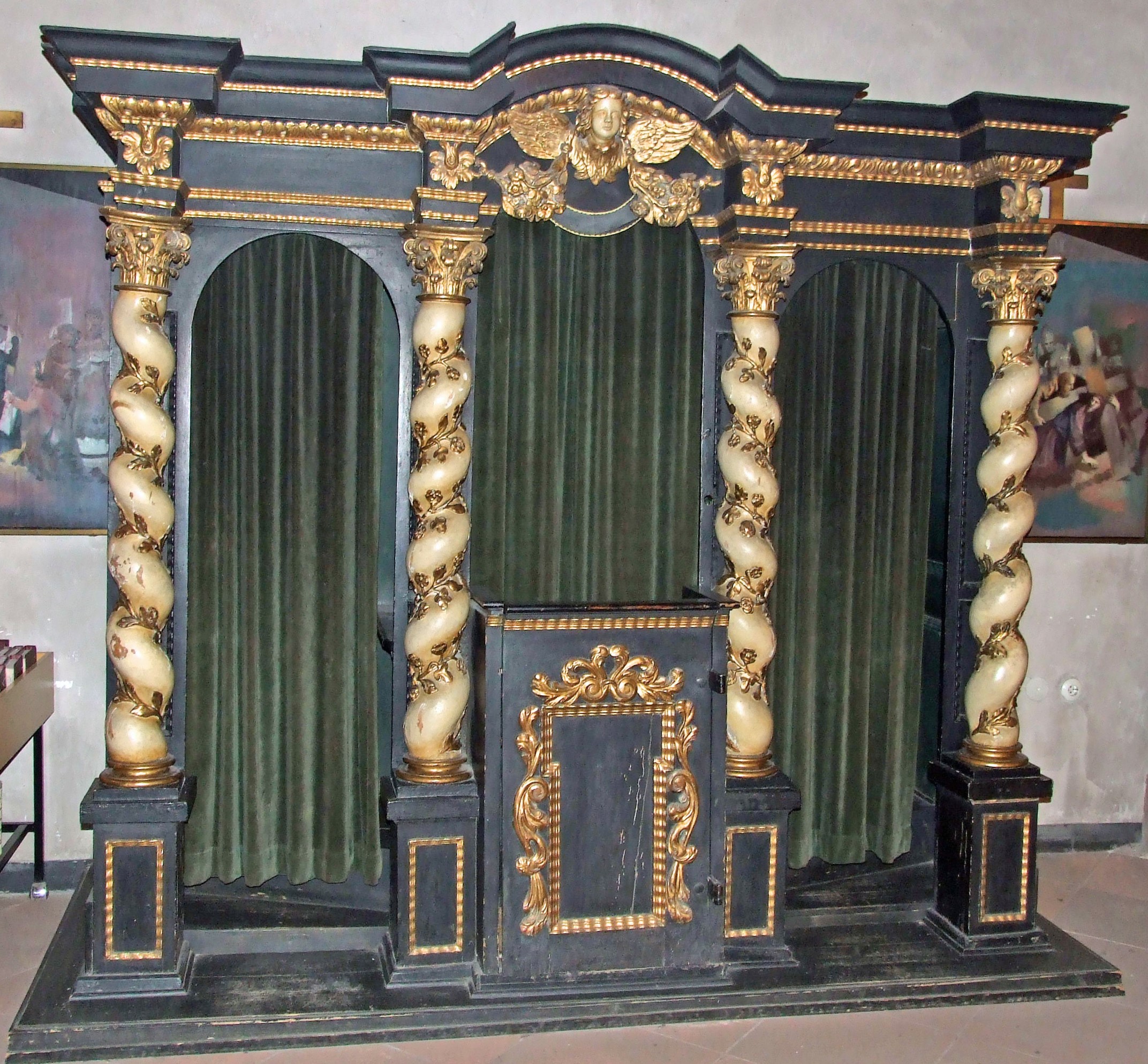|
Mourner's Bench
The mourners' bench, also known as the mercy seat or anxious bench, in Methodist and other evangelical Christian churches is a bench located in front of the chancel. The practice was instituted by John Wesley, the founder of the Methodist Church. Individuals kneel at the mourners' bench to experience the New Birth and some of those who have already had the New Birth go there to receive entire sanctification, while others, especially backsliders, use the mourners' bench to confess their sins and receive forgiveness, in order to continue the process of sanctification. At the mourners' bench, individuals receive spiritual counsel from a minister. In keeping with the doctrine of the mortification of the flesh, penitents do not kneel on kneeler cushions but instead kneel on the floor. Today many, but not all, Methodist churches supplant the mourners' bench with chancel rails, where Methodists (as well as other evangelical Christians) receive Holy Communion, in addition to experienc ... [...More Info...] [...Related Items...] OR: [Wikipedia] [Google] [Baidu] |
Mortification Of The Flesh
Mortification of the flesh is an act by which an individual or group seeks to mortify or deaden their sinful nature, as a part of the process of sanctification. In Christianity, mortification of the flesh is undertaken in order to repent for sins and share in the Passion of Jesus. Common forms of Christian mortification that are practiced to this day include fasting, abstinence, as well as pious kneeling. Also common among Christian religious orders in the past were the wearing of sackcloth, as well as self-flagellation in imitation of Jesus Christ's suffering and death. Christian theology holds that the Holy Spirit helps believers in the "mortification of the sins of the flesh." Verses in the Old Testament (Hebrew Bible) considered to be precursors to Christian ideas of self-mortification include Zechariah 13:6 and 1 Kings 18:28–29. Although the term 'mortification of the flesh', which is derived from the King James version of Romans 8:13 and Colossians 3:5, is primarily ... [...More Info...] [...Related Items...] OR: [Wikipedia] [Google] [Baidu] |
Conditional Preservation Of The Saints
The conditional preservation of the saints, or conditional perseverance of the saints, or commonly conditional security, is the Arminian Christian belief that believers are kept safe by God in their saving relationship with him upon the ''condition'' of a persevering faith in Christ. Arminians find the Scriptures describing both the initial act of faith in Christ, "whereby the relationship is effected", and the persevering faith in him "whereby the relationship is sustained." The relationship of "the believer to Christ is never a static relationship existing as the irrevocable consequence of a past decision, act, or experience." Rather, it is a living union "proceeding upon a living faith in a living Savior." This living union is captured in the simple command by Christ, "Remain in me, and I in you" (). According to Arminians, biblical saving faith expresses itself in love and obedience to God ( Galatians 5:6; Hebrews 5:8–9). In the ''Remonstrant Confession'' of 1621, the first ... [...More Info...] [...Related Items...] OR: [Wikipedia] [Google] [Baidu] |
Altar Call
An altar call is a tradition in some Christian churches in which those who wish to make a new spiritual commitment to Jesus Christ are invited to come forward publicly. It is so named because the supplicants gather at the altar located at the front of the church building. Most altar calls occur at the end of an evangelical address. Background Altar calls are a recent historic phenomenon beginning in the 1830s in America. During these, people approached the chancel rails, anxious seat, or mourner's bench to pray. One of the most famous 19th century revivalists, Charles Grandison Finney, "popularized the idea of the 'altar call' in order to sign up his converts for the abolition movement." In many Churches of the Wesleyan-Arminian theology, the altar call, in addition to being an invitation for people to experience the New Birth, is also often used to implore believers to experience the second work of grace, known as entire sanctification. Notable examples in history of using a ... [...More Info...] [...Related Items...] OR: [Wikipedia] [Google] [Baidu] |
Christian Prayer
Christian prayer is an important activity in Christianity, and there are several different forms used for this practice. Christian prayers are diverse: they can be completely spontaneous, or read entirely from a text, such as from a breviary, which contains the canonical hours that are said at fixed prayer times. While praying, certain gestures usually accompany the prayers, including folding one's hands, bowing one's head, kneeling (often in the kneeler of a pew in corporate worship or in the kneeler of a prie-dieu in private worship), and prostration. The most common prayer among Christians is the "Lord's Prayer", which according to the gospel accounts (e.g. Matthew 6:9-13) is how Jesus taught his disciples to pray. The injunction for Christians to pray the Lord's prayer thrice daily was given in '' Didache'' 8, 2 f., which, in turn, was influenced by the Jewish practice of praying thrice daily found in the Old Testament, specifically in , which suggests "evening and m ... [...More Info...] [...Related Items...] OR: [Wikipedia] [Google] [Baidu] |
Holy Communion
The Eucharist (; from Greek , , ), also known as Holy Communion and the Lord's Supper, is a Christian rite that is considered a sacrament in most churches, and as an ordinance in others. According to the New Testament, the rite was instituted by Jesus Christ during the Last Supper; giving his disciples bread and wine during a Passover meal, he commanded them to "do this in memory of me" while referring to the bread as "my body" and the cup of wine as "the blood of my covenant, which is poured out for many". The elements of the Eucharist, sacramental bread (leavened or unleavened) and wine (or non-alcoholic grape juice), are consecrated on an altar or a communion table and consumed thereafter, usually on Sundays. Communicants, those who consume the elements, may speak of "receiving the Eucharist" as well as "celebrating the Eucharist". Christians generally recognize a special presence of Christ in this rite, though they differ about exactly how, where, and when Christ is pres ... [...More Info...] [...Related Items...] OR: [Wikipedia] [Google] [Baidu] |
Communion Rails
The altar rail (also known as a communion rail or chancel rail) is a low barrier, sometimes ornate and usually made of stone, wood or metal in some combination, delimiting the chancel or the sanctuary and altar in a church, from the nave and other parts that contain the congregation. Often a gate, or just a gap, at the centre divides the line into two parts. Rails are a very common, but not inevitable, feature of Roman Catholic, Anglican, Lutheran, and Methodist churches. They are usually about two feet 6 inches high, with a padded step at the bottom, and designed so that the wider top of the rail can support the forearms or elbows of a kneeling person. The altar rail is a modest substitute for earlier barriers demarcating the chancel, the area containing the altar, which was reserved (with greatly varying degrees of strictness) for officiating clergy (including boys as choristers and altar servers). Although it only emerged after the Protestant Reformation, it has been found con ... [...More Info...] [...Related Items...] OR: [Wikipedia] [Google] [Baidu] |
Kneeler
A kneeler is a cushion (also called a tuffet or hassock) or a piece of furniture used for resting in a kneeling position during Christian prayer. In many churches, pews are equipped with kneelers in front of the seating bench so members of the congregation can kneel on them instead of the floor. In a few other situations, such as confessionals and areas in front of an altar, kneelers for kneeling during prayer or sacraments may also be used. Traditionally, altar rails often have built-in knee cushions to facilitate reception of Holy Communion while kneeling. A kneeler is also a part of the prie-dieu prayer desk. Kneelers in churches are a modern development. Kneeling was not part of the Mass in early Christianity, and has been part of the Catholic Mass since the 16th century. See also * Hassock * Knee pad Knee pads or kneepads are protective gear worn on knees to protect them against impact injury from falling to the ground or hitting an obstacle, or to provide pa ... [...More Info...] [...Related Items...] OR: [Wikipedia] [Google] [Baidu] |
Sanctification
Sanctification (or in its verb form, sanctify) literally means "to set apart for special use or purpose", that is, to make holy or sacred (compare la, sanctus). Therefore, sanctification refers to the state or process of being set apart, i.e. "made holy", as a vessel, full of the Holy Spirit of God. The concept of sanctification is widespread among religions, including Judaism and especially Christianity. The term can be used to refer to objects which are set apart for special purposes, but the most common use within Christian theology is in reference to the change brought about by God in a believer, begun at the point of salvation and continuing throughout the life of the believer. Many forms of Christianity believe that this process will only be completed in Heaven, but some believe that complete holiness is possible in this life. Judaism In rabbinic Judaism sanctification means sanctifying God's name by works of mercy and martyrdom, while desecration of God's name means ... [...More Info...] [...Related Items...] OR: [Wikipedia] [Google] [Baidu] |
Methodist
Methodism, also called the Methodist movement, is a group of historically related denominations of Protestant Christianity whose origins, doctrine and practice derive from the life and teachings of John Wesley. George Whitefield and John's brother Charles Wesley were also significant early leaders in the movement. They were named ''Methodists'' for "the methodical way in which they carried out their Christian faith". Methodism originated as a revival movement within the 18th-century Church of England and became a separate denomination after Wesley's death. The movement spread throughout the British Empire, the United States, and beyond because of vigorous missionary work, today claiming approximately 80 million adherents worldwide. Wesleyan theology, which is upheld by the Methodist churches, focuses on sanctification and the transforming effect of faith on the character of a Christian. Distinguishing doctrines include the new birth, assurance, imparted righteousness ... [...More Info...] [...Related Items...] OR: [Wikipedia] [Google] [Baidu] |
Confession (religion)
Confession, in many religions, is the acknowledgment of one's sins (sinfulness) or wrongs. Christianity Catholicism In Catholic teaching, the Sacrament of Penance is the method of the Church by which individual men and women confess sins committed after baptism and have them absolved by God through the administration of a priest. The Catholic rite, obligatory at least once a year for serious sin, is usually conducted within a confessional box, booth or reconciliation room. This sacrament is known by many names, including penance, reconciliation and confession. While official Church publications usually refer to the sacrament as "Penance", "Reconciliation" or "Penance and Reconciliation", many clergy and laypeople continue to use the term "Confession" in reference to the Sacrament. For the Catholic Church, the intent of this sacrament is to provide healing for the soul as well as to regain the grace of God, lost by sin. A perfect act of contrition, wherein the penitent ex ... [...More Info...] [...Related Items...] OR: [Wikipedia] [Google] [Baidu] |
Backsliders
Backsliding, also known as falling away or described as "committing apostasy", is a term used within Evangelical Christianity to describe a process by which an individual who has converted to Christianity reverts to pre-conversion habits and/or lapses or falls into sin, when a person turns from God to pursue their own desire. To revert to sin or wrongdoing, especially in religious practice, someone lapses into previous undesirable patterns of behavior. To be faithful, thus to believe backsliding is a reversion, in principle upholds the Apostle Paul’s condition in salvation: "If you declare with your mouth, “Jesus is Lord,” and believe in your heart that God raised him from the dead, you will be saved." Romans 10:9 (TNIV). In Christianity, within the Roman Catholic Church as well as those denominations which teach Arminianism such as the Methodist Churches, backsliding is a state which any free-willed believer is capable of adopting. This belief is rejected by Calvinists en ... [...More Info...] [...Related Items...] OR: [Wikipedia] [Google] [Baidu] |

.jpg)




.jpg)

